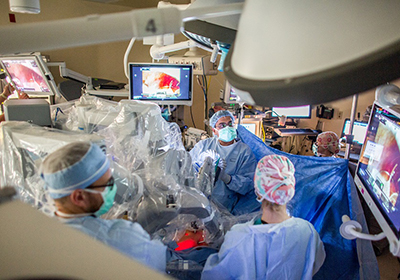 Surgeons are using the da Vinci Surgical System to repair hernias for patients at Harris Health System’s Lyndon B. Johnson Hospital, and the results could be far-reaching for similar safety-net hospitals across the country.
Surgeons are using the da Vinci Surgical System to repair hernias for patients at Harris Health System’s Lyndon B. Johnson Hospital, and the results could be far-reaching for similar safety-net hospitals across the country.
Through a pilot program to determine its benefits, the da Vinci robotic system is in five hospitals located in financially disadvantaged communities nationwide. The robotic technology allows surgeons to use magnified 3D high-definition monitors to control tiny instruments—bending and rotating more deftly than human hands—to make precise cuts and seals inside the human body.
 Dr. Tien C. Ko, chief of staff and chief, Surgery Department, LBJ Hospital, and associate dean for Harris Health Programs at McGovern Medical School at the University of Texas Health Science Center at Houston (UTHealth), and hospital administrators spearheaded the effort to enroll the hospital in the program.
Dr. Tien C. Ko, chief of staff and chief, Surgery Department, LBJ Hospital, and associate dean for Harris Health Programs at McGovern Medical School at the University of Texas Health Science Center at Houston (UTHealth), and hospital administrators spearheaded the effort to enroll the hospital in the program.
“We wanted something that would enhance or improve the surgical care and medical outcomes of the patients we serve at Harris Health System and LBJ Hospital,” Ko says. “We chose hernias for the da Vinci because they’re challenging to repair and achieve superior outcomes, so the robot may offer some advantages.”
As part of the research, staff will compare and contrast results of laparoscopic (minimally invasive) and da Vinci-aided hernia surgeries. They’re looking at reported levels of pain, complications and the need for follow-up repairs after surgeries.
“We’ll probably know the answer to the question of pain in two to four months after a patient’s surgery, but for the question on whether it’s a better repair, we’re going to have to follow a patient for a year or two because that’s when up to 30-40 percent of hernia repairs recur,” Ko says.
He believes da Vinci may reduce a patient’s pain after surgery because of its pinpoint cuts and reduced scar tissue. However, that’s still to be proven.
“The idea with robotic surgery is that you hopefully get better securing of the mesh,” Ko adds. “Again, that’s the hypothesis, so we’ll have to test it. I don’t think there’s any high-quality research yet that shows robotics to be superior.”
 Renee Russell, MSN, RN, NEA-BC, CNOR, director, Nursing Perioperative Services, LBJ Hospital, is cautiously optimistic about what the research will prove. However, her team of nurses and scrub techs are excited to participate and learn about the new technology.
Renee Russell, MSN, RN, NEA-BC, CNOR, director, Nursing Perioperative Services, LBJ Hospital, is cautiously optimistic about what the research will prove. However, her team of nurses and scrub techs are excited to participate and learn about the new technology.
“We have a waiting list of staff wanting to train and do cases using da Vinci,” she says. “It’s something they really want to be a part of. I’m hopeful the research will show the advantages of robotic-assisted procedures and contribute to Harris Health’s efforts to provide our patients the best possible care.”
To ensure da Vinci is a good value for the hospital, only experienced surgeons and nursing staff run the controls. Dr. Shinil K. Shah, medical director, da Vinci Surgical System, LBJ Hospital and associate professor, Department of Surgery, McGovern Medical School at UTHealth, has performed hundreds of successful robotic-aided cases and believes the technology is good for patients.
“We obviously have residents and nurses learning, but the faculty surgeons should be experts and shouldn’t have a learning curve,” Shah says. “This is why we feel our cases at LBJ Hospital are cost-effective and any conversion (transition to open surgery if cases become complicated) is very low.”
Shah says true proficiency in robotic-aided surgery is achieved after 50 successful cases. Despite the continued success of robotics, he is surprised more specialties and hospitals don’t use less invasive procedures—even if not robotics—as opposed to open or more invasive surgeries.
“A lot of what we’re seeing across the country is that robotics allows doctors to do minimally invasive surgery cases,” he adds. “If you can encourage more doctors to do minimally invasive procedures and robotics is a tool that encourages it—that’s where it probably has the most value for patient care.”